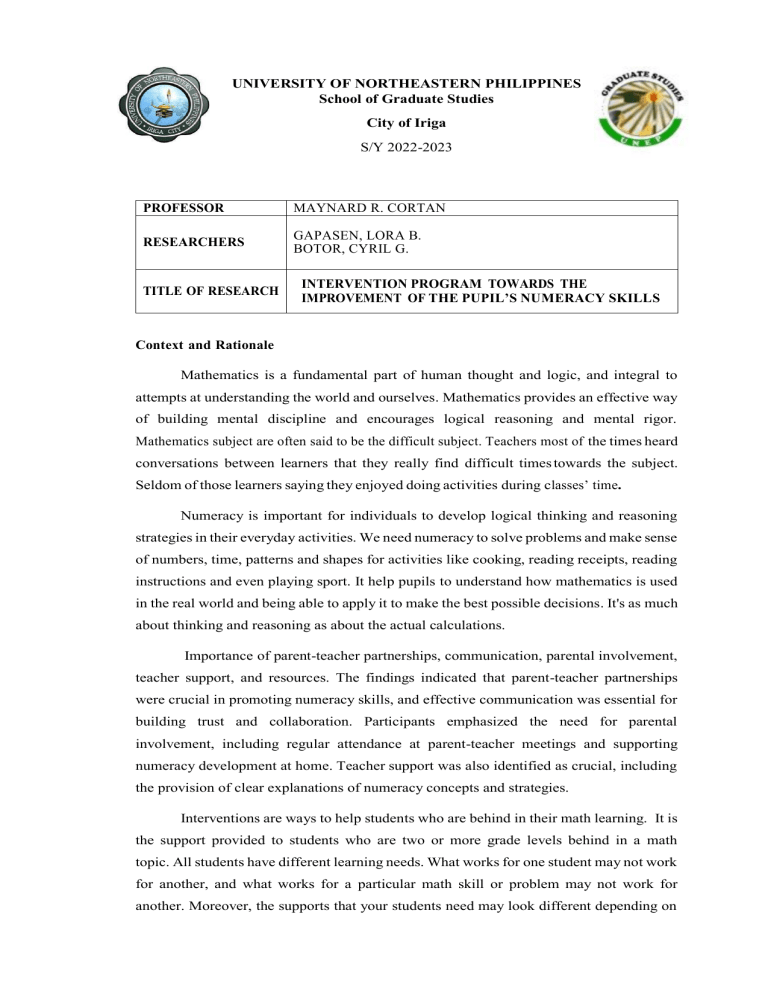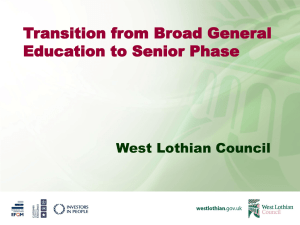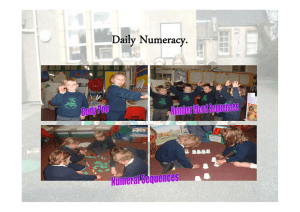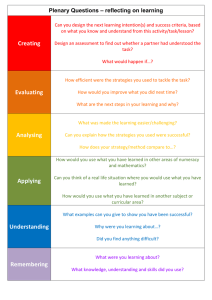
UNIVERSITY OF NORTHEASTERN PHILIPPINES School of Graduate Studies City of Iriga S/Y 2022-2023 PROFESSOR MAYNARD R. CORTAN RESEARCHERS GAPASEN, LORA B. BOTOR, CYRIL G. TITLE OF RESEARCH INTERVENTION PROGRAM TOWARDS THE IMPROVEMENT OF THE PUPIL’S NUMERACY SKILLS Context and Rationale Mathematics is a fundamental part of human thought and logic, and integral to attempts at understanding the world and ourselves. Mathematics provides an effective way of building mental discipline and encourages logical reasoning and mental rigor. Mathematics subject are often said to be the difficult subject. Teachers most of the times heard conversations between learners that they really find difficult times towards the subject. Seldom of those learners saying they enjoyed doing activities during classes’ time. Numeracy is important for individuals to develop logical thinking and reasoning strategies in their everyday activities. We need numeracy to solve problems and make sense of numbers, time, patterns and shapes for activities like cooking, reading receipts, reading instructions and even playing sport. It help pupils to understand how mathematics is used in the real world and being able to apply it to make the best possible decisions. It's as much about thinking and reasoning as about the actual calculations. Importance of parent-teacher partnerships, communication, parental involvement, teacher support, and resources. The findings indicated that parent-teacher partnerships were crucial in promoting numeracy skills, and effective communication was essential for building trust and collaboration. Participants emphasized the need for parental involvement, including regular attendance at parent-teacher meetings and supporting numeracy development at home. Teacher support was also identified as crucial, including the provision of clear explanations of numeracy concepts and strategies. Interventions are ways to help students who are behind in their math learning. It is the support provided to students who are two or more grade levels behind in a math topic. All students have different learning needs. What works for one student may not work for another, and what works for a particular math skill or problem may not work for another. Moreover, the supports that your students need may look different depending on classroom capacity or the organization of specialized intervention support within your school or district. Feel free to try the ideas below, adapting them to your individual students. Therefore, with the aid of intervention programs the pupils may cope with the class discussions. It help the pupils better understand the math subject and they will be more knowledgeable enough in terms of numeracy. They will be honed and trained by means of intervention programs that will be handled by educators. Action Research Questions This study aims to determine the effects of intervention program towards the improvement ofthe pupil’s numeracy skills Specifically, the study aims to answer the following questions: 1. What is the level of performance of the pupils that are lag behind per grade level in terms of: 1.1 numeracy skills; and 1.2 Comprehension skills? 2. What is the level of performance of the pupils that are lag behind per gradelevel after the implementation of the intervention program in terms of: 2.1 numeracy skills; and 2.2 comprehension skills 3. Is there a significant difference on the level of performance of the pupils thatare lag behind per grade level as compared to after the implementation of the intervention program? Proposed Innovation, Intervention and Strategy This research aims to promote and help those learners who have bad times towards learning Mathematics mostly during this time of pandemic. This study exerts many efforts to reachout to those individuals who are in need and to ensure that the learners may not be left behind. Most problems and issues of schools before the pandemic are the low performances of the pupils in some major areas mostly mathematics. During Pandemic the performances of pupils continuously decreasing. Due to the absence of face to face learning modality. During this new normal, the concern arises having the fact that only parents and elders are now the acting teachers to them. The concerns on finding solutions to the low performing pupils are seems more complicated to address due to the situations. With this research, intervention program towards the improvement ofthe pupil’s numeracy skills which are one-on-one tutorial, redo activities with low scores and provide supplementary materials and activities that aims to uplift Mathematics competencies among learners. We proposed this study to poster academic ease among learners who are facing the new normal of education set-upof today’s situation. This is a tutorial-based program wherein all the respective advisersare the tutors to the identified learners who fall short towards the mastery of thelessons, who did not able or late to submit their outputs weekly or as determined by teachers. The tutorial session offers are categorize according to the extent of the needed assistance by every learners such as: Category for Tutorial 1. Strategies Utilize Numeracy Skills Systematic and explicit instruction Visual representation of functions and relationships, such as manipulative, pictures and graphs 2. Comprehension Skills(Problem Solving related activities) Peer-assisted instruction Ongoing, formative assessment Improving Problem Solving Improving Reading Skills To ensure the smooth and continues flow of this entire research, step by step process are being considered like the following: The school mathematics team headed by the school math coordinator conducted series of meeting physically. 1. Presentation of project proposal, Gantt Chart of Activities to the School Principal by the school coordinators. 2. Determination of identified respondents by all advisers after a week answering the activities given. Constant communication with them or even parents were all undertaken. 3. Home visitation of target client/s by every adviser in order that the project will be explained properly to the parents for the important role they must portraythe entire project implementation. Parents and School Agreement were also presented and signed by them as proof that they understand the entire process and that they are willing to help for the benefits of their children. 4. Distribute the supplementary materials and conduct tutorials. 5. Regular feedbacking and “Kamustahan” with the pupils and parents Action Research Methods by A. Participants and/or other Sources of Data and Information The respondents of this study are the 100 selected pupils who are considered lag behind in Mathematics subject at Fatima Integrated Farm School, Inc. for the School Year 20222023.They are the learners that needs assistance in order to cope up with the lessons in which they fall short to follow and understand as base on the assessment of teachers to the performances of learners during the end of the school year. B. Data Gathering Methods This study will utilize the descriptive comparative design. Descriptive design is used to collect information about variables without changing the environment. According to Gray et al., (2013), descriptive designs may be used to identify problemsin current practice, make judgments, or even develop theories. Since the study compared variables from the performances from the previous activities and the current performances without manipulating the independent variable, the researchers adopted the comparative design within descriptive research. In gathering the data, the researcher utilizes a pretest and posttest self-made questionnaires that will be answered by the respondents before and after the tutorial activities catered. After the data has been gathered, tabulation and analyses are applied using the determined data analyzing tool to determine the outcomes of thestudy. Participants are selected in non-random manner and identified by the researcher base on the level of capabilities. The respondents are identified upon the assessment of the teachers based on their responses at the end of the school year in mathematics subject. C. Data Analysis Plan The performance level of the respondents that are lag behind in terms of numeracy and comprehension skills is identified through computing with the use of frequency, percentage distributions and rank. On the other hand, to compute thesignificant difference on the level of performance of the pupils that are lag behind per grade level as compared to after the implementation of the intervention program towards the improvement ofthe pupil’s numeracy skills. The result of the self-made test utilize during pre-test and posttest, the statistical test that the study utilize is a two-sample t-test since the data are obtained within two groups with different sample sizes. A two-sample t-test is applicable in the comparison of two (2) mean or percentages of two (2) samples when the standard deviation is already given. Furthermore, it is commonly used to test if a new process or treatment is superior to a current process or treatment (Snedecor and Cochran, 1989) which is suitable in this study. The study started in February 2023 and ended in June 2023, covering the third and fourth quarters. Action Research Work Plan and Timelines ACTIVITIES 1. Research Team Planning of research proposal 2. Drafting part I-Introduction to Research Methodology of the research study 3.Drafting of Pre-test, Post Test and Questionnaire Checklist 4. Preparation and Validation of Questionnaire-Checklist 5. Administration of Pre-test to the selected respondents 6. Presentation of research proposal 7. Administration of the tutorial to help improved pupils’ performance who are lag behind 8. Administration of Post-test and the questionnairechecklist to the respondents 9. Retrieval of test questionnaire and Questionnaire-Checklist Feb 2023 Mar 2023 April 2023 May 2023 June 2023 10. Data analysis, calculation and tabulation of results -Discussion of Results based on Tabulation. 11. Completion of research output 12. Final revision of output 13. Presentation of results of the conducted research Plans for Dissemination and Utilization DESSIMINATION ACTIVITIES 1. Research Proposal to School Head for schoolimplementation of the research output 2. School implementation of the output of the research study 3. Post Evaluation of the research study Implementation 4. Results of Post evaluation after school implementation, gone through series of revisions and planning for proposal to the district level for adoption of the study 5. Community proposal through the Barangay Officials for the possible extension of the implementation of the project for wider spread of its conduct 6. Meeting with possible community tutors( Barangay Citizen as volunteer teachers/tutors) with the cooperation of the Barangay Officials 7. District proposal of Outputs for possible adoption Feb 2023 Mar2023 April 2023 May 2023 June 2023 8. District implementation of the output of the research study 9. Results of Post evaluation after district implementation, gone through series of revisions and planning for proposal to the district level for adoption of the study 10. Division proposal of Outputs for possible adoption 1. Research Proposal to School Head for school implementation of the research output 2. School implementation of the output of the research study 3. Post Evaluation of the research study Implementation REFERENCES Carbonel, L.G.(2013). Parents Role in Enhancing the Academic Performance of Students in the Study of Mathematics in Tabuc City”, Philippines International Journal of Advanced Research in Management and Social Science, Vol. 2 No. 8. ISSN 2278-8236. Gray, D. E. (2013). Doing Research in the Real World. Sage. Kolb, A. Y., and Kolb, D. A. (2009). Experiential learning theory: A dynamic, holistic approach to management learning, education management learning, education and development. The SAGE handbook of and development, 42, 68 Santiago, Everlina G. (June 2010). The Modern Teacher “On Selecting and Preparing Variety of Teaching Methods.” Snedecor, George W. and Cochran, William G. (1989). Statistical Methods, Eighth Edition, Lowa State University Press. Tam, M. (2000). Constructivism, instructional design, and technology: Implications for transforming distance learning. Journal of Educational Technology & Society, 3(2), 50-60. Tambychik, T., Meerah, T. S., & Aziz, Z. (2010). Mathematics Skills Difficulties: A Mixture of Intricacies. Procedia - Social and Behavioral Sciences, 7, 171-180. doi:10.1016/j.sbspro.2010.10.25





